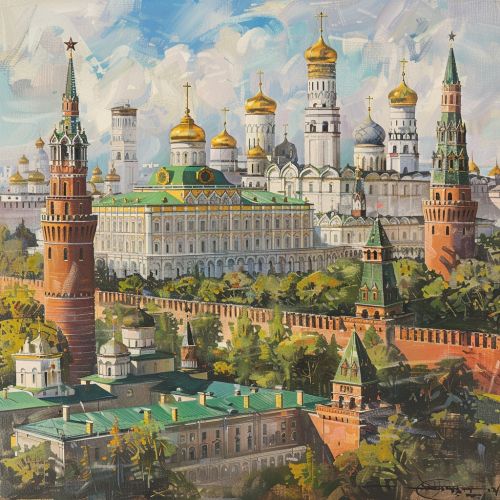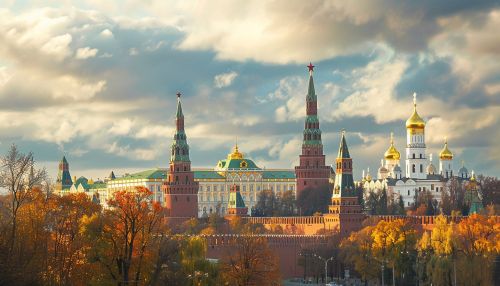Rurik Dynasty
Origins and Early History
The Rurik Dynasty, also known as the Rurikids, was a ruling dynasty in Kievan Rus', the Grand Duchy of Moscow, and later the Tsardom of Russia. The dynasty is traditionally considered to have been founded by the Varangian prince Rurik, who established his rule in Novgorod around 862 AD. The origins of the Rurikids are rooted in the Varangian (Viking) culture, which had significant influence over the early Slavic tribes in Eastern Europe.
The primary source of information about the early Rurikids is the Primary Chronicle, a historical record compiled in the 12th century. According to the chronicle, Rurik and his brothers, Sineus and Truvor, were invited by the local Slavic and Finnic tribes to rule over them and bring order to the region. Rurik's descendants expanded their influence, establishing control over key cities such as Kiev, which became the center of the Kievan Rus' state.
Expansion and Consolidation
Under the leadership of Rurik's successors, the Rurikid dynasty expanded its territories and consolidated power. Rurik's son, Oleg of Novgorod, is credited with moving the capital to Kiev and establishing the Kievan Rus' state. Oleg's military campaigns extended the influence of the Rurikids over neighboring tribes and territories, including the Drevlians, Severians, and Radimichs.
Oleg's successor, Igor of Kiev, continued to strengthen the dynasty's rule, although his reign was marked by conflicts with the Drevlians, which ultimately led to his death. Igor's widow, Olga of Kiev, served as regent for their son, Sviatoslav I, and is noted for her efforts to consolidate power and her conversion to Christianity, which laid the groundwork for the Christianization of Kievan Rus'.
Christianization and Cultural Development
The Christianization of Kievan Rus' was a pivotal moment in the history of the Rurik Dynasty. Vladimir the Great, the grandson of Olga, played a crucial role in this transformation. In 988 AD, Vladimir converted to Christianity and declared it the state religion, aligning Kievan Rus' with the Byzantine Empire and fostering cultural and religious ties.
The adoption of Christianity had profound effects on the society and culture of Kievan Rus'. It facilitated the development of written language, with the introduction of the Cyrillic script, and promoted the construction of churches and monasteries. The influence of Byzantine art, architecture, and religious practices became evident in the region, contributing to the cultural flourishing of Kievan Rus'.
Fragmentation and Decline
The death of Yaroslav the Wise in 1054 marked the beginning of the fragmentation of Kievan Rus'. Yaroslav's sons divided the realm among themselves, leading to a period of internecine conflict and political instability. The once-unified state gradually disintegrated into a collection of rival principalities, each ruled by different branches of the Rurikid family.
The Mongol invasion in the 13th century further weakened the Rurikid principalities. The Mongol Empire established the Golden Horde, which exerted suzerainty over the Russian lands, demanding tribute and influencing local politics. Despite the fragmentation and external pressures, the Rurikid princes continued to rule their respective territories, maintaining a degree of autonomy.
Rise of Moscow and the Grand Duchy
The rise of the Grand Duchy of Moscow marked a new chapter in the history of the Rurik Dynasty. Ivan I of Moscow, also known as Ivan Kalita, played a key role in consolidating power in Moscow and expanding its influence. By aligning with the Mongol rulers and collecting tribute on their behalf, Ivan Kalita strengthened Moscow's position and laid the foundation for its future dominance.
Ivan's successors, including Dmitry Donskoy, continued to expand Moscow's territories and challenge Mongol authority. Dmitry's victory at the Battle of Kulikovo in 1380 was a significant milestone, demonstrating the growing power of Moscow and its ability to resist Mongol control. The Grand Duchy of Moscow gradually emerged as the leading principality among the fragmented Russian states.
Establishment of the Tsardom of Russia
The transformation of the Grand Duchy of Moscow into the Tsardom of Russia was a pivotal moment in the history of the Rurik Dynasty. Ivan IV, also known as Ivan the Terrible, was the first ruler to be officially crowned as Tsar of All Rus' in 1547. Ivan's reign was marked by significant territorial expansion, centralization of power, and the establishment of a centralized autocratic state.
Ivan IV's policies, including the Oprichnina, aimed to consolidate his authority and suppress opposition. His reign saw the conquest of the Khanates of Kazan, Astrakhan, and Siberia, expanding Russian territory significantly. However, Ivan's later years were characterized by political instability, internal strife, and economic challenges.
Decline and End of the Rurik Dynasty
The death of Ivan IV in 1584 marked the beginning of the decline of the Rurik Dynasty. His son, Feodor I, was a weak ruler, and his death in 1598 without an heir led to a dynastic crisis known as the Time of Troubles. This period was characterized by political chaos, foreign intervention, and widespread social unrest.
The Time of Troubles ended with the establishment of the Romanov Dynasty in 1613, marking the end of the Rurikid rule. The Romanovs, who were related to the Rurikids through marriage, continued to build on the foundations laid by their predecessors, eventually transforming Russia into a major European power.
Legacy and Historical Significance
The legacy of the Rurik Dynasty is deeply embedded in the history and culture of Russia and Eastern Europe. The Rurikids played a crucial role in the formation and development of the early Russian state, laying the foundations for its political, cultural, and religious identity. Their contributions to the Christianization of Kievan Rus', the establishment of key cities, and the expansion of Russian territories have left an enduring impact on the region.
The Rurikid princes are also remembered for their patronage of the arts, architecture, and literature. The construction of iconic churches, such as the Saint Sophia Cathedral in Kiev, and the promotion of literary works, including the Primary Chronicle, are testaments to their cultural legacy.
See Also


